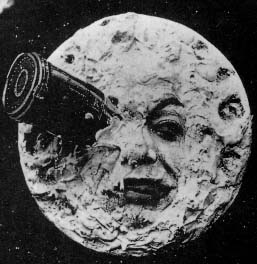A Trip to the Moon (French: Le Voyage dans la Lune) is a 1902 French silent film directed by Georges Méliès. Inspired by a wide variety of sources, including Jules Verne's novels From the Earth to the Moon and Around the Moon, the film follows a group of astronomers who travel to the Moon in a cannon-propelled capsule, explore the Moon's surface, escape from an underground group of Selenites (lunar inhabitants), and return to Earth with a captive Selenite - wikipedia ![]()
It features an ensemble cast of French theatrical performers, led by Georges Méliès himself in the main role of Professor Barbenfouillis, and is filmed in the overtly theatrical style for which Méliès became famous.
The film was an internationally popular success on its release, and was extensively pirated by other studios, especially in the United States. Its unusual length, lavish production values, innovative special effects, and emphasis on storytelling were markedly influential on other film-makers and ultimately on the development of narrative film as a whole.
ARCHIVE Levoyagedanslalune
Le voyage dans la lune. By George Melies, an old 1902 film from france about a small group of scientists that travel to space on a rocket to get to the moon - archive.org ![]()
Scholars have commented upon the film's extensive use of pataphysical and anti-imperialist satire, as well as on its wide influence on later filmmakers and its artistic significance within the French theatrical féerie tradition. Though the film disappeared into obscurity after Méliès's retirement from the film industry, it was rediscovered around 1930, when Méliès's importance to the history of cinema was beginning to be recognised by film devotees. An original hand-colored print was discovered in 1993 and restored in 2011.

Screenshot from Le Voyage dans la lune (A Trip to the Moon) (1902)
- wikimedia ![]()
A Trip to the Moon was an internationally popular success on its release and was extensively pirated by other studios, especially in the United States. Its unusual length, lavish production values, innovative special effects, and emphasis on storytelling were markedly influential on other filmmakers and ultimately on the development of narrative film as a whole. It was ranked 84th of the 100 greatest films of the 20th century by The Village Voice. The film remains Méliès' best known, and the moment in which the capsule lands in the Moon's eye remains one of the most iconic and frequently referenced images in the history of cinema. It is widely regarded as the earliest example of the science fiction film genre and, more generally, as one of the most influential films in cinema history.
# Rediscovery
After Méliès's financial difficulties and decline, most copies of his prints were lost. In 1917, his offices were occupied by the French military, who melted down many of Méliès's films to gather the traces of silver from the film stock and make boot heels from the celluloid.
HTML5 webm https://upload.wikimedia.org/wikipedia/commons/6/6c/Le_Voyage_dans_la_lune_%28black_and_white%2C_1902%29.webm
The restored black-and-white print of ''A Trip to the Moon''; runtime 00:12:47 - wikimedia.org ![]()
When the Théâtre Robert-Houdin was demolished in 1923, the prints kept there were sold by weight to a vendor of second-hand film. Finally, in that same year, Méliès had a sudden fit of rage and burned all his remaining negatives in his garden in Montreuil. In 1925, he began selling toys and candy from a stand in the Gare Montparnasse in Paris. ''A Trip to the Moon'' was largely forgotten to history and went unseen for years - wikipedia ![]()
# Hand-colored print
No hand-colored prints of ''A Trip to the Moon'' were known to survive until 1993, when one was given to the Filmoteca de Catalunya by an anonymous donor as part of a collection of two hundred silent films. It is unknown whether this version, a hand-colored print struck from a second-generation negative, was colored by Elisabeth Thuillier's lab, but the perforations used imply that the copy was made before 1906. The flag waved during the launching scene in this copy is colored to resemble the flag of Spain, indicating that the hand-colored copy was made for a Spanish exhibitor - wikipedia ![]()

A frame from the restored hand-colored print of ''A Trip to the Moon''